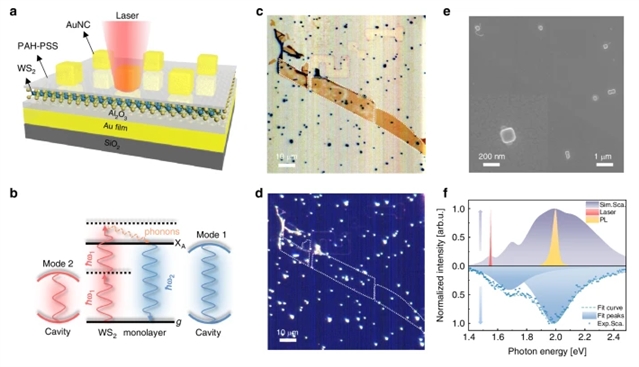
近日,南开大学齐鹏飞团队研究了双共振等离子体纳米腔中二维激子的巨大双光子上转换。该研究于2025年9月10日发表在《光:科学与应用》杂志上。
高谐波产生、多光子吸收、俄格复合和声子散射等光子上转换在能量转换和重整化过程中起着至关重要的作用。考虑到减少的介电屏蔽和增强的库仑相互作用,半导体单层为探索室温下的光子上转换提供了一个有前景的平台。此外,由于双光子上转换与传统激发相比具有非凡的选择规则,因此最近被证明是一种新兴的探测激子暗态的技术。
然而,由于多光子吸收效率有限和辐射寿命长,高效的双光子上转换仍然是一个挑战。在双共振等离子体纳米腔中,由于光收集放大、激发速率增强和量子效率提高,双光子发光(TPL)增强了2440倍。
为了更深入地了解这种等离子体激元的吸引双共振增强,研究组在350 K下实现了激子耦合系统、激子热调谐上转换和优化放大因子>3000。同时,对单共振增强光致发光(PL)(~890倍)和二次谐波产生(SHG)(~134倍)进行了详细的论证。这些结果为开发低成本、高性能的非线性光子器件和通过配置等离子体纳米腔探测精细激子态奠定了基础。
附:英文原文
Title: Giant two-photon upconversion from 2D exciton in doubly-resonant plasmonic nanocavity
Author: Liu, Fangxun, Liu, Haiyi, Chi, Cheng, Qian, Wenqi, Dai, Yuchen, Tao, Guangyi, Lin, Sihan, Ding, Shihan, Yu, Menghan, Liu, Hongliang, Lin, Lie, Qi, Pengfei, Fang, Zheyu, Liu, Weiwei
Issue&Volume: 2025-09-10
Abstract: Photon upconversion through high harmonic generation, multiphoton absorption, Auger recombination and phonon scattering performs a vital role in energy conversion and renormalization. Considering the reduced dielectric screening and enhanced Coulomb interactions, semiconductor monolayers provide a promising platform to explore photon upconversion at room temperature. Additionally, two-photon upconversion was recently demonstrated as an emerging technique to probe the excitonic dark states due to the extraordinary selection rule compared with conventional excitation. However, highly efficient two-photon upconversion still remains challenging due to the limited multiphoton absorption efficiency and long radiative lifetimes. Here, a 2440-fold enhancement of two-photon luminescence (TPL) is achieved in doubly resonant plasmonic nanocavities due to the amplified light collection, enhanced excitation rate, and increased quantum efficiency. To gain more insight into the attractive doubly resonant enhancement in such a plasmonexciton coupling system, the intriguing thermally tuned excitonic upconversion and optimized amplification factor >3000 are realized at 350K. Meanwhile, the single resonance enhanced photoluminescence (PL) (~890-fold) and second-harmonic generation (SHG) (~134-fold) are elaborately demonstrated. These results establish a foundation for developing cost-effective, high-performance nonlinear photonic devices and probing fine excitonic states via configuring plasmonic nanocavities.
DOI: 10.1038/s41377-025-02010-w
Source: https://www.nature.com/articles/s41377-025-02010-w
Light: Science & Applications:《光:科学与应用》,创刊于2012年。隶属于施普林格·自然出版集团,最新IF:19.4
官方网址:https://www.nature.com/lsa/
投稿链接:https://mts-lsa.nature.com/cgi-bin/main.plex
